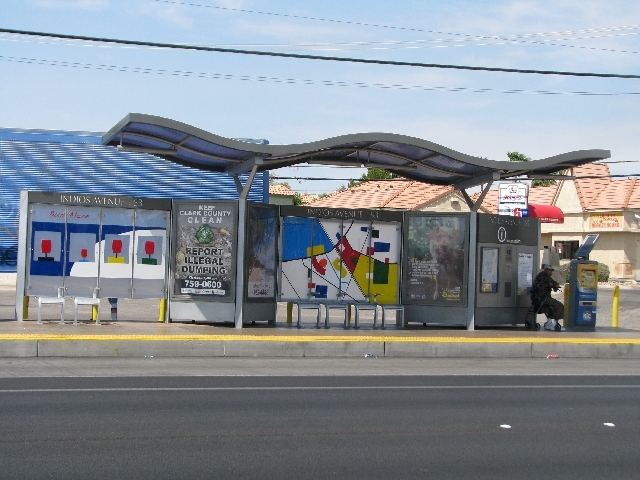RTC bus stop project comes with hurdles
The Regional Transportation Commission of Southern Nevada is taking steps to make bus shelters safer for pedestrians and transit customers, but sometimes obstacles get in the way.
A study was conducted by the commission’s Transportation Resource Board that concluded that 90 percent of roadway crashes are contained within the roadway and 6 feet on either side of it.
“One of our first decisions was not to put shelters on sidewalks,” said Carl Scarborough, manager of transit advertising and amenities for the commission. “Putting our shelters behind the sidewalk moves the people more than 6 feet from the roadway.”
In some cases, that means shifting one of the old shelters back to a new cement pad, but some of the older ones were custom-designed for a location or are in too much disrepair to move.
Scarborough said vehicles crashing into bus shelters accounts for less than one-half of a percent of road accidents.
“On the average, a bus shelter somewhere in the valley gets hit two or three times a month, but it’s usually in the middle of the night when no one is there,” Scarborough said.
“Pedestrians are a bigger number, bicycles are a bigger number, but most of it is motorist to motorist,” Scarborough said. “Bus shelters are a small percentage of the problem, but that doesn’t mean that it’s not serious and we aren’t working on it.”
Before 2005, the installation and upkeep of bus shelters were handled by each jurisdiction, which resulted in six agreements, with two companies doing the work at bus shelters. A law passed by the Nevada Legislature in 2005 put the commission in charge of bus shelters, with the company Outdoor Promotions conducting the work. Scarborough said that since taking charge, the commission has put safety and complying with the Americans with Disabilities Act at the top of its priorities.
The commission designed new shelters with solar panels on the roof and LED lights and put 40 of them on the Strip. A simpler version called a general market shelter was designed for use across the valley.
“Because the new shelters use solar power and LED lighting, they don’t have to be tied into the power grid,” Scarborough said. “We just pour the slab and bolt them down.”
The new shelters cost $8,200 to build, and when the cost of design, permitting, installation, the concrete slab and installation are added, the price tag is $15,000 per shelter. The commission installs 150 per year and is just wrapping up the second set of 150. There are 700 more locations targeted for shelters, and Scarborough hopes to have that part of the project done in less than five years.
“My budget comes from the transit operations budget,” Scarborough said. “We could go out and fix all the stops right now, but we’d have no money for bus service.”
There are 2,100 bus stops in the valley. Angela Castro, manager of government affairs and media relations for the commission, said the sites for the new shelters are carefully selected.
“We have a list of all stops ranked by the number of passenger boardings per day,” Castro said. “We looked at each stop, starting with the busiest, and went down the line.”
The commission has a flow chart to determine if a stop is suitable for a shelter. If the site has no shelter, is suitable for one and there is public land on which to put it, the site goes on the list. There is one other consideration, however.
“We monitor environmental justice. We can’t just put all of our shelters in Summerlin,” Scarborough said. “We spread them out across communities to make sure our phases are balanced.”
Complications arise when land behind the sidewalk isn’t publicly owned or the stop is backed by a wall. For the most part, putting a shelter at these locations is set aside while Scarborough and his staff of five deals with the more straightforward installations. The commission works with Clark County and the cities of Las Vegas, North Las Vegas and Henderson to acquire easement to build new shelters.
“They have been very responsive when we have a special request or issue,” Castro said. “They’re very good about requiring new developers to provide a right of way for bus shelters. It’s the retrofitting and going back that’s a little harder.”
Castro said the city of Las Vegas has set aside $1 million to purchase easements for bus shelters.
In some cases, the property owners are happy to work with the commission. Scarborough cited a stop in front of the Suncoast, 9090 Alta Drive, that is a public/private partnership with the casino.
“They built it. They maintain it. We operate it,” Scarborough said.
Not all property owners are comfortable with the idea of a bus shelter and will not work with the commission. In other cases, the owner simply can’t be reached.
“The site of the crash on Spring Mountain (Road) and Decatur (Boulevard) was on the list for further study,” Scarborough said “There was nothing we could do about it because there was no easement and no right of way behind the sidewalk. We had to set it aside.”
The accident at the site on Sept. 13, 2012, occurred when a driver traveling an estimated 80 mph went airborne at the intersection and plowed through the bus shelter, killing four and injuring eight, officials said. The commission has renewed efforts to contact the out-of-state property owner to no avail.
“You’ve got a property owner who doesn’t answer their phone and doesn’t respond to mail,” Scarborough said.
The commission’s Transportation Resource Board study suggested an arsenal of changes to bus stops when moving them back was not feasible, including reducing speed limits, raising the curbs, adding barriers and other measures.
Contact Sunrise/Whitney View reporter F. Andrew Taylor at ataylor@viewnews.com or 702-380-4532.




























